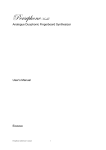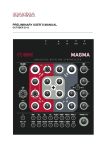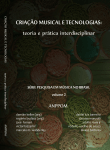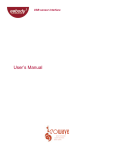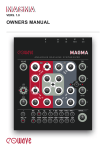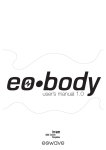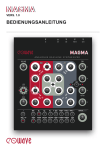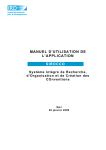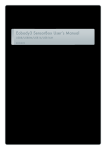Download Mesi Monstersynths The Persephone User`s manual
Transcript
The Persephone Analogue Fingerboard Synthesizer User’s Manual MESI MONSTERSYNTHS - 2- Table Of Contents Cautions Background From the Idea to the First Steps Connections Synthesis Section Control Section Hierarchy Of Controls Modes Table MDI Implementation Terms Of Warrant CE & FCC The Persephone, user’s manual, mesi©2006 4 5 8 10 11 12 14 15 16 17 19 - 3- You’re now the owner of a Persephone, a wonderful new instrument inspired by the first electronic non-keyboard instruments whilst featuring the most advanced sensor technology. We hope you enjoy it and that it brings a new dimension to your creativity. The Persephone is a handmade instrument and therefore, individual units can differ from one another. For any questions, please contact monstersynths at [email protected] CAUTION! Before using the Persephone, make sure you have read the following instructions carefully, as well as the instructions for use. RISK OF ELECTRIC SHOCK, DO NOT OPEN OR MODIFY THE PERSEPHONE REFER SERVICING TO QUALIFIED SERVICE PERSONNEL. TO REDUCE THE RISK OF ELECTRIC SHOCK, DO NOT REMOVE COVER (OR BACK). NON USER-SERVICEABLE PARTS INSIDE. Do not try to repair the Persephone, its ribbon, its expression key or its components inside. Please contact Monstersynths for technical support. Avoid all sharp object contact on the ribbon. Do not use the Persephone or store it under extreme temperature conditions or expose it to direct sunlight, damp or dusty areas, areas prone to strong vibrations. Before you plug in the Persephone, always check the voltage. Protect the Persephone against violent shocks. Before using the Persephone in a foreign country, check if the voltage is compatible. When the Persephone is not used, switch the unit off. Never place heavy objects on the Persephone. Never touch the Persephone with wet hands when it is plugged in. Before moving the Persephone, make sure the unit is disconnected from other devices. Before cleaning the Persephone, make sure the unit is switched off and not plugged in. During lightning, unplug the Persephone. The Persephone, user’s manual, mesi©2006 - 4- Background: The Idea Of the Persephone Keyboards have become the prime user interface for controlling synthesizers. But the supremacy of keyboard interfaces has not always been so throughout synthesizer history… Let’s go back to these other concepts which are now part of our cabinet of curiosities... Since the dawn of electronics and the creation of the first electronic oscillators, scientists have been aware of the potential of electronics for generating sounds and many of them have tried to create electronic musical instruments with more or less success. The introduction of filters and VCA soon enabled to play tremolos and vibratos which could recreate the musicality of classical instruments. And in an attempt to control these parameters, these new instruments opened the field of the research for new controls beyond the possibilities that a generic keyboard could offer. The fact that most of the non-keyboard instruments with their new controllers required a new playing technique explains why they remained unpopular with musicians who had little time to practice on unusual keyboards, the Telharmonium 36-note-per-octave keyboard designed by Cahill for example. Some others, like Leon Theremin, set up classes where their new instruments would be taught. The 1920s remain the most fertile years for the evolution of electronic music instruments with the invention of new controls like dial-operated non keyboard electronic instruments or ribbon controlled instruments. In Russia, Lev Sergeyevich Termen developed the Theremin using the body capacitance as a control mechanism and thus freeing the performer from the keyboard and fixed intonation. He also created the first fingerboard cellos. In France and in Germany, a whole family of dial-operated non keyboard electronic instruments was developed. Among them, René Bertrand and Edgard Varèse’s Dynaphone or Jörg Mager's Electrophon and Sphärophon. The Persephone, user’s manual, mesi©2006 - 5- At the end of the 1920s, the fingerboards – or ribbon controllers - were to appear with Les Ondes Martenot designed by the French Maurice Martenot which included both a seven-octave keyboard and a ribbon controller that allowed pitch inflections similar to a voice or string instrument. It allowed for a wide glissando when the player moved a finger ring attached to the metal ribbon that controlled frequency. Hundreds of symphonic works, operas, ballets, and film scores were composed for this instrument by Varèse, Honneger and Messiaen. Since that, ribbon controllers have had a long and distinguished history in electronic musical instruments. Peter Lertes, an electrical engineer in Leipzig and Bruno Helberger, developed the Hellertion, also one of the first electronic instruments to use a fingerboard continuous controller instead of a keyboard. The fingerboard was a flat metal resistance strip covered in leather which when pressed closed a circuit. Depending on where the strip was pressed, a different resistance in the circuit was created altering the voltage sent to the oscillator and thereby producing different pitches. The force of the pressure controlled the volume of the output signal. The fingerboard was marked to help the performer find the correct pitch on the strip and had a range of approximately five octaves. The original instrument had just one fingerboard strip which was gradually increased to four and then on the later models, six aligned in parallel horizontally at the height of a piano keyboard. The four and six strip models allowed four and six voice polyphony when the strip could be played simultaneously with fingers and thumbs. The Trautonium was the first instrument to ally position and pressure control. Created in 1931 by Friedrich Trautwein, the Trautonium used filters to modify the timbre of the note and a keyboard, just like Les Ondes Martenot. The Original Trautonium had a fingerboard consisting of a resistance wire made of a tube of graphite stretched over a metal bar marked with a chromatic scale and coupled to a neon tube oscillator. When the performer was pressing the wire, it would touch the bar and close the circuit. The oscillator was amplified via a loudspeaker. The position of the finger on the wire determined the resistance controlling the frequency and therefore controlled the pitch of the oscillator. The Trautonium had a three octave range that could be transposed by means of a switch. The Persephone, user’s manual, mesi©2006 - 6- An additional series of circuits could be added to control the timbre of the note by amplifying the harmonics of the fundamental note, non harmonic partials could also be added by selective filtering. This unique form of subtractive synthesis produced a tone that was distinctive and unusual when compared to the usual heterodyning valve instruments of the 1920-30s. The foot pedal of the machine controlled the overall volume. The "Sonar", developed by N. Anan'yev in the USSR from 1930 also had a fingerboard continuous controller to vary the pitch of the oscillator. After the 40s, the general use of keyboards (and the war) slowed down the research of new types of controls. Ribbon controllers were back in the 1960s with Moog ribbon controllers which Keith Emerson was famous for attaching to a pyrotechnics control. The Theremin-like sound in the Beach Boys' song "Good Vibrations," was played by a ribbon-controlled instrument called the Electro-Theremin which the Beach Boys have later replaced by a Moog ribbon controller with a Moog synthesizer in live performances. Between the mid-1970s and mid-1980s, several different types of nonkeyboard synthesizer controllers were developed, in particular percussion, guitar and wind. Only a few synthesizers from the 1980s had other types of controls: the Yamaha CS80’s ribbon controller, which unlike pitch-bend wheels and the Moog ribbon controller design, has no centre position. Kurzweil also included ribbon control to their synths, the Korg Prophecy as well. Some more controllers have been designed in the 1980s, but remained very uncommon. Michel Waisvisz developed The Hands, during the early 1980s at STEIM in Amsterdam. At the turn of the 21st century, new possibilities arose with the development of sensor technology and new computer controls while the development of powerful flexible sensor interfaces like the eobody developed by eowave/Ircam was transcending the limits of traditional controls… And this new taste for other sorts of control has entered the world of electronic music with controllers like the Kaoss Pad or tactile surface controllers. The Persephone, user’s manual, mesi©2006 - 7- From the Idea to the First Steps: A choice of technology We decided to work on a contemporary version of a fingerboard instrument, using the latest controls today’s technology would bring but preserving the best of analogue sound generators. The Persephone reminds us of the first electronic instruments. It is made of noble woods with its wenge exotic wood expression key, its birch panel and its oak wooden sides. Beyond this vintage look, the Persephone allies sensors technology and digital controls to a pure analogue generation of sound. With its analogue oscillator, the Persephone can generate notes with a range of 10 octaves, which goes from a deep and resonant cello tone to a nearly human voice. And on the highest pitches, it can reach very high frequencies. The oscillator waveform can be set between triangle and sawtooth for a more or less brilliant sound. Its ribbon virtual control surface requires the most advanced sensor technology and allows all kinds of glissando a Theremin or Les Ondes Martenot would allow, though the sensored ribbon is much more precise than the tube full of graphite used as a variable resistance in the Trautonium. A scaling potentiometer allows scaling the Persephone’s ribbon from 1, 2, 5 to 10 octaves. The expression key, controlled by an optical sensor can transmit the slightest vibrations on the key with an accuracy the mechanical systems never had. All the controls are digital. The four play modes - A, B, C and D - offer different hierarchy of control between the pitch, the velocity, a filter modulation and an LFO. The Persephone, user’s manual, mesi©2006 - 8- The first prototype was presented in January 2004 at the Winter NAMM Show in Los Angeles and in April 2004 at the Frankfurt Musik Messe. Two years later, the final version has been released with many improvements and new functions, like MIDI in & out, full tone and half tone modes… The design has also been improved allowing a full accessibility to the control panel. The buttons are on the left side of the control panel, directly accessible with the left hand, while the right hand can keep playing. Connections are located on the rear side of the control panel and protected from dust and other sources of deterioration by the Persephone suitcase top when closed. Two versions of the instrument have been released: a desktop version and a suitcase version (classic or the colourful punk-rock version). Just like on a Theremin, the way the Persephone is played will define the instrument’s personality. The Persephone follows the traditional playing style of the first non-keyboard electronic instruments with the right hand controlling the pitch and the left hand controlling the velocity. The ribbon zone size allows all kinds of playing technique. When scaled, the Persephone can be played like a regular keyboard. Though there are no fixed preset notes on the ribbon, keyboard players will easily find their way. Nevertheless, it is possible to add some reference marks noted on a strip of white tape. (In this case, only use alcohol to remove the glue of the tape). Guitar and bass players will certainly play it like a chord instrument and get sounds that are close to cello or violin, especially when using vibratos. Jazz players will enjoy slapping the Persephone’s ribbon to get wonderful sonorities. The Persephone, user’s manual, mesi©2006 - 9- Connections Connections are located on the rear side of the control panel and protected from dust and other sources of deterioration by the Persephone suitcase top when closed. For the desktop version, we recommend to cover the unit with a cloth when not used to avoid dust. To remove dust from the unit, make sure the unit is turned off and clean it with a damp cloth only. 220V/110V The Persephone has either a 220V or a 110V internal power supply. The 220V or 110V voltage is specified on the rear side. Always check the voltage before plugging the unit in, especially if you are in a foreign country. Never open the unit when it is switched on. on/off To turn the unit on, flick the on/off switch. When on, the LED on the front panel is on. Fuse The Persephone has an internal fuse to avoid the risk of damages. Pedal in You may plug an expression pedal into the Pedal in jack 6,35 input. With this pedal, you will be able to control the volume, but also the LFO frequency in mode C (See Modulation section, Mode C). out out is the main audio out. Plug it to your amplifier audio in. Beware! Plugging the audio out into the Pedal in will shut the Persephone down and may be a cause of severe damages to the unit. Recommended amplifier type You may use all types of guitar amplifier. The Persephone sound generator is 100% analogue, therefore, it can reach very high frequencies. Always turn down the volume of your amplifier when you first play the Persephone to avoid any damage to your loud speakers. If you add a little reverberation to the sound it will sound great. MIDI in/out Connect to your MIDI devices to use the Persephone as a MIDI controller. (See MIDI implementation). The Persephone, user’s manual, mesi©2006 - 10 - CV Connect the CV out to the CV in of another analogue synthesizer to control it with the Persephone. For a CV connection, the pitch is on the tip and the velocity on the ring. The Persephone, user’s manual, mesi©2006 - 11 - Synthesis Section The Persephone has all the functions of a synthesizer with signal processing sections with an oscillator (and its common functions tune, finetune, wave, velocity, volume), a low-pass filter which modulates the oscillator (modulation, filter freq), an LFO. The synthesis section is 100% analogue. Osc section wave – tune – finetune - volume The sound of the Persephone is generated by a 100% analogue oscillator. Like all analogue oscillators, its sound can differ depending on temperature conditions. Wave: two waveforms from triangle to sawtooth. Tune: tunes the oscillator Finetune: adjusts the finetune of the oscillator Volume: adjusts the main volume Filter section FilterFreq - modulation Low-pass filter: The Persephone has an analogue 6dB low-pass filter which modulates the sound source. You can set the filter frequency with the knobs ‘filterfreq’ and its modulation amount with the knob ‘mod’ Filter: The knob ‘filterfreq’ sets the frequency at which the filter opens and closes. Modulation: The knob ‘modulation’ sets the modulation amount the filter has on the sound source. LFO section Mode C & D – volume On Mode C and D, the sound source will be modulated by an LFO you may control via an expression pedal connected to the Pedal In of the Persephone to create tremolos and vibratos. The Persephone, user’s manual, mesi©2006 - 12 - Control Section The Persephone controllers are 100% digital. The Persephone has four control tools: the ribbon which allows pressure and position control, the expression key and the volume pedal. Ribbon CAUTION! The ribbon is very fragile. Avoid sharp object contact with the ribbon. Do not try to remove the ribbon from the panel. To clean the ribbon, use a dry cloth. The ribbon responds to changes in voltage or resistance caused by changing the finger position along its surface. The Persephone ribbon controller is also able to record pressure or velocity. The ribbon is a linear potentiometer that generates different control voltages depending on where it is touched. These changes in voltage are applied to the voltage-controlled oscillator and the filter. The voltage fluctuations are also translated into binary data and used to control digital modulation. Scale: allows scaling the Persephone’s ribbon from 1, 2, 5 to 10 octaves. The Persephone can generate sounds beyond the frequencies human beings can hear. Your pets may be very sensitive to some high frequencies… Position: the position of your finger will determine the pitch of the note played. Pressure: the pressure of your finger will control the velocity (mode A) or the amplitude (mode B, C, D) of the note played. In all the modes A, B, C and D, the position on the ribbon will always determine the pitch. In mode A, the pressure on the ribbon will control the velocity of the note, (the filter frequency being controlled by the pressure). In all other modes, the pressure controls the amplitude of the note. The Persephone, user’s manual, mesi©2006 - 13 - Expression key The wenge expression key controls the filter. Its optical sensor is able to reproduce the slightest movement of the key. A great control tool for tremolos. In mode A, the expression key will control the amplitude of the note, reminding us of Les Ondes Martenot expression key. In mode B, the expression key will control the filter frequency for the velocity. In mode C, the expression key will control the modulation amount of the LFO depth on the amplitude of the note to modulate a tremolo. In mode D, the expression key will control the modulation amount of the LFO depth on the pitch of the note to modulate a vibrato. Expression pedal An expression pedal can be connected to the Pedal in at the rear side of the Persephone to control the volume (modes A and B) or the LFO speed (modes C and D). In modes A and B, the expression pedal will control the volume of the note. In mode C, the expression pedal will control the modulation amount of the LFO speed on the amplitude of the note to modulate a tremolo. In mode D, the expression key will control the modulation amount of the LFO speed on the pitch of the note to modulate a vibrato. The Persephone, user’s manual, mesi©2006 - 14 - Hierarchy Of Controls Mode A, B, C & D Mode A In mode A, the Persephone will play the ‘classical way’ with the right hand controlling the pitch via the position on the ribbon and the filter frequency via the pressure on the ribbon. The left hand on the expression key plays on the amplitude of the note while the pedal controls the volume. Mode B In mode B, the pitch is determined by the position of the fingers on the ribbon, just like in the other modes. The pressure on the ribbon will determine the amplitude of the note. The expression key will control the filter frequency while the pedal controls the volume. Mode C or tremolo mode The particularity of mode C is the tremolo. The ribbon controls are the same as in mode B with the position on the ribbon determining the pitch and the pressure controlling the amplitude of the note. The tremolo is reproduced by the action of the LFO on the amplitude of the note. The tremolo parameters (depth and speed) will be controlled by the expression key (tremolo depth) and the pedal (for the tremolo speed). Mode D or vibrato mode The particularity of mode D is the vibrato. The ribbon controls are the same as in mode B and C with the position on the ribbon determining the pitch and the pressure controlling the amplitude of the note. The vibrato is the action of the LFO on the pitch of the note. The vibrato parameters (depth and speed) will be controlled by the expression key (vibrato depth) and the pedal (for the vibrato speed). The Persephone, user’s manual, mesi©2006 - 15 - Modes Table Mode A Control types Ribbon position Pitch Ribbon pressure Filter frequency Expression key amplitude B Pitch amplitude Filter frequency C (tremolo) Pitch amplitude D (vibrato) Pitch amplitude Modulation amount (Tremolo depth) Modulation amount (Vibrato depth) The Persephone, user’s manual, mesi©2006 Pedal Volume/ amplitude Volume/ amplitude Tremolo speed Vibrato speed - 16 - MIDI Implementation MIDI option is set by default. Receive channel 1- 16 Pressing the expression key while powering up the unit will disactivate MIDI. Sending Control Change Message Key CC-7 Pressure CC-1 Pedal CC-2 Pitch – Pitch bend Note to be sent Note on 60/vel 127 while pressing the ribbon, Note of 60/vel 0 while releasing the finger from the ribbon Sending MIDI PROGRAM CHANGE Message will affect different parameters of the Persephone Changing the MIDI channel MIDI CHANNEL PC 1 –16 (on current midi channel) The midi channel is stored in an non volatile flash ram Use the Persephone as a MIDI controller To use the Persephone as a MIDI controller or to be able to record and playback the sound on a sequencer, it should be set to local OFF mode after each powering up. MIDI LOCAL ON PC 20 (on current midi channel) (default value) MIDI LOCAL OFF PC 21 (on current midi channel) MIDI KB half tone mode The half tone mode enables to trigger only half tone notes from the ribbon and send them via MIDI. The mode 1 calculates the nearest 1/2 tone from the first pitch played and sends the pitchbend of that note. It will also affect the internal oscillator by playing only half tone notes at each first contact onto the ribbon. The mode 2 only sends notes. MIDI KB 1/2 TONE mode OFF PC 22 (default value) MIDI KB 1/2 ON mode 1 PC 23 MIDI KB 1/2 ON mode 2 PC 24 The Persephone, user’s manual, mesi©2006 - 17 - Terms of Warrant The Persephone has a one year term warrant after the date of purchase. Shipping the unit back to MESI will be at the charge of the owner. Any damage resulting from misuse of the instrument is not covered by the warrant. MESI MONSTERSYNTHS Team The Persephone has been designed and developed by Marc Sirguy, MESI/eowave CEO. Aesthetic design, manual, marketing and export: Emmanuelle Gallin. German version of the manual: Robert M. Heininger. Special thanks to Gabriel Zurini for his help with the first prototypes and for his helpful hints. Thank you to all who have shown their interest since the very beginning of this project. Contact & Support MESI 6, rue Marceau - 94200 Ivry-sur-Seine – France Tel: +33/1 45 15 41 95 - Fax : +33/1 45 15 07 24 [email protected] – www.eowave.com - www.monstersynths.com CE & FCC Information 1. Important notice: do not modify this unit. This product, when installed as indicated n the instructions contained in this manual, is compatible with the CE norm & FCC requirements. 2. Important! When connecting this product to accessories or/and to another product, use only high quality shielded cables. Cables supplied with this product must be used. Follow all installation instructions. Failure to follow instruction could void your FCC authorization to use this product in the USA. 3. Note: this product has been tested and found to comply with the requirements listed in the FCC Regulations, Part 15 for Class B digital devices & in The European Standart EN 50081-1 on Electromagnetic Compatibility – Generic emission standart on residential, commercial and light industry. Compliance with these requirements provides a reasonable level of assurance that the use of this product in a residential environment will not result in harmful interference with other electronic devices. The Persephone, user’s manual, mesi©2006 - 18 - MESI MONSTERSYNTHS 6, Rue Marceau 94200 Ivry-sur-Seine France The Persephone, user’s manual, mesi©2006


















